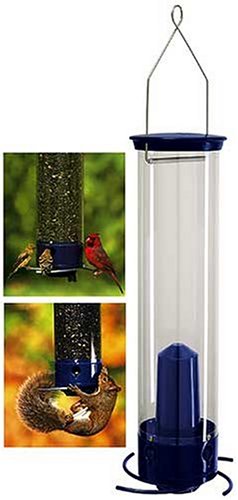Teaching your children how to build a bird feeder is a very simple task. It doesn't take any skill or a lot of knowledge, and it will be great to build the children's knowledge as well as helping you spend some quality time with them.
You should first purchase the materials ahead of time, so that all you have to do when you begin teaching the children how to build a bird feeder.
You will need to buy some bird feed 4 - 12 inch 1 inch by 2 inch boards 1 - 12 inch by 12 inch piece of 3/8 inch plywood An 8 foot 2 inch by 4 inch wall stud A roll of craft wire A 3/8 inch dowel approximately 3 or 4 inches long A heavy plastic or metal lid
Then gather your tools that you will need.
A hammer Some 1 inch nails A drill and a ¼ inch bit A pair of wire cutters A step ladder A jig saw A pair of safety glasses And a set of post hole diggers
Place the post hole diggers and the step ladder near the location that you are planning to set up the bird feeder.
Then place the tools and the materials on a work bench that can easily be observed by the children.
You may want to cut the 2x4 stud with the jig saw first, marking off a 1 ½ foot mark, and labeling the area below the mark to go into the ground. Then make another mark 4 or 5 feet from the mark that you just made, and cut at the top mark. The remaining length of the 2x4 stud will be to hold the bird feeder. After cutting 2 of the 1x2 strips into 12 inch pieces, and 2 strips 11 inches, the remainder of the strip can be cut to whatever the distance would be from the L shape structure that you just cut, using it for a brace.
Take the craft wire and cut it into 4 - 2 foot lengths, and lay them to the side.
Now your are ready to assemble the bird feeder with a squirrel deterrent.
Place the 1 foot x 1 foot piece of plywood flat on the work bench and nail one of the 1x2 precut strips on the plywood. Then place one of the 11 inch pieces beside the first piece that you just nailed down. Do this on all four sides of the bird feeder until you have a 2 inch edge around the plywood.
On each end of the plywood you should now put a nail in each corner of the plywood being careful to leave half of the head of the nail sticking out.
Take one of the 2 foot wires that you just cut and wrap it around one of the protruding nails in one of the corners and then do the same to the remaining three nails.
Take your plastic lid that you are going to use to keep the squirrels from stealing all the bird seed, and drill a hole directly in the center, this will allow you to string the wire through the hole. With the jig saw cut your dowel into five or more even lengths, or you may just only want to use one of the pieces to hold up the lid. Next take one of the pieces of dowel and make a loop in the wire about 1 foot up the wire and twist the dowel around the wire pulling it tightly.
After you have all this done, move all the parts to the site you are going to set the bird feeder up, if you haven't already. Nail the shortest 2x4 piece of wall stud to the top of the longest piece by laying both pieces on the ground, then nail a piece of 1x2 strips to form a brace for the L shape that you just made.
Place the structure in the ground and dill it with dirt. Using your step ladder take the 4 strands of wire and pull them through the hole in the plastic lid all the way down to the dowel. Carefully twist the remaining wire around the short end of the L shape and put some bird seed in the feeder. Now all you have to do is keep watch for any birds that will come to feed.
Building a bird feeder is as exciting to build for you as well as teaching your children how to do a project.
 | Price : $73.23
| Price : $73.23










